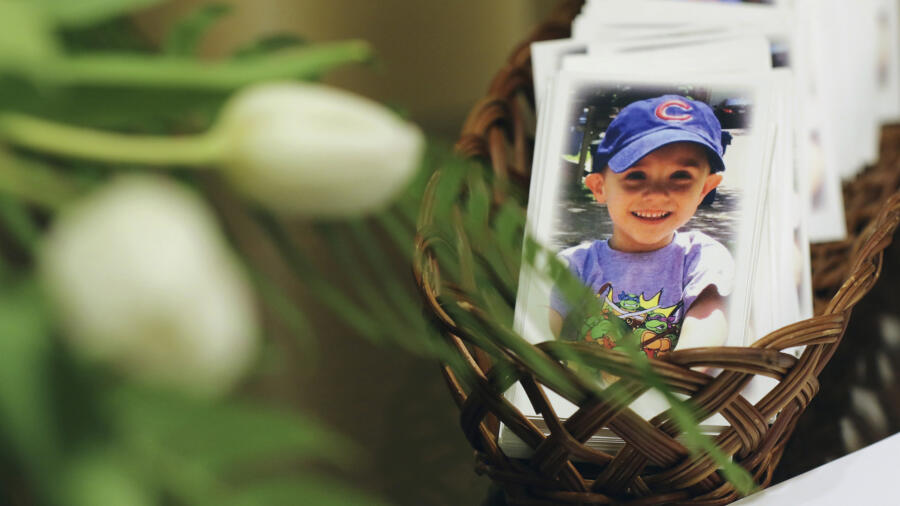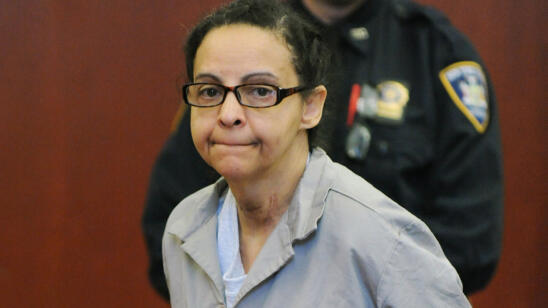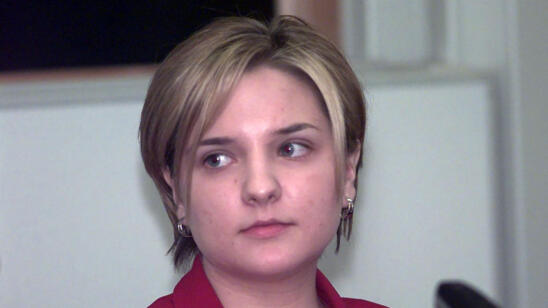The following content contains disturbing accounts of violence. Discretion is advised.
While other 5-year-olds in his Chicago suburb cuddled stuffed toys and slept soundly, Andrew “AJ” Freund spent his last night freezing and in pain.
The little boy who relatives called “smart” and “curious” was forced into a cold shower, then fatally battered at his Crystal Lake home on April 15, 2019, police say.
AJ’s father initially reported his son was missing, but after finding the boy’s body in a nearby field, authorities charged parents JoAnn Cunningham and Andrew Freund Sr., with murder on April 25.
Born with drugs in his system, AJ was fostered briefly by family members who described him as someone who “loved having books read to him, doing puzzles (and) his Thomas the Train.”
Freund Sr. and Cunningham have pleaded not guilty and a trial is months off. [Editor’s Update: In December 2019, Cunningham pleaded guilty to the first-degree murder of her son. On July 17, 2020, she was sentenced to 35 years in prison. Freund Sr. has maintained his plea of not guilty.]
Meanwhile, grief is still fresh in AJ’s community as neighbors wonder, “why?”
There’s no simple profile of a parent who commits filicide. But risk factors can include being abused as a child, mental illness and addictions to alcohol or drugs, experts say.
In cases of extreme violence, many parents fall back on denial or rationalization, Robert Geffner, president and founder of the Institute on Violence, Abuse and Trauma tells A&E True Crime.
“They convince themselves they were trying to help the child and that in disciplining the child they were providing what they think was appropriate parenting to change misbehavior,” Geffner says.
A parent may think: “‘It’s not my fault, the behavior of the child forced me to do to this … therefore it’s their fault I’m beating them,'” explains Geffner, distinguished research professor of psychology at Alliant International University in San Diego.
“I don’t think most parents intend to murder their child. What happens is the behavior escalates and results in death.”
What Can You Do?
If you suspect a child is being abused but feel conflicted about whether or not you should tell someone, you may feel empowered knowing you have some options.
“You can report anonymously,” says David Finkelhor, a University of New Hampshire sociology professor and director at the Crimes Against Children Research Center. “You can [also] call the state’s child abuse hot line and discuss the matter to get their expert opinion without disclosing the identity of the child involved.”
And you may be legally obligated to say something as well. “In 16 states, all citizens are ‘mandatory reporters,'” says Finkelhor, meaning they are required by law to report any “suspicion” of child maltreatment.
A Shallow Grave
On April 24, Freund Sr. guided police to AJ’s body wrapped in plastic and buried in a field.
An affidavit filed by Sheriff’s Detective Edwin Maldonado quotes Freund Sr. saying his wife thought AJ had a defiance disorder.
“AJ thinks of himself as the leader of the house and therefore he is defiant to his parents, lies (and) disobeys,” Freund Sr. told the police.
He cited AJ washing the dishes poorly and being punished by being locked in his room for hours, Maldonado testified.
Police also found deleted video where a woman believed to be Cunningham berates AJ, who is bruised and naked for wetting his bed.
Toxic Triggers
Abuse and neglect killed 1,750 children in 2016, a U.S. Department of Health and Human Services July 2018 study found.
The ones responsible 78 percent of the time are “parents—acting alone or with another parent or individual,” HHS reports.
Family violence expert Emily Douglas is a professor and head of the Department of Social Science and Policy Studies at Worcester Polytechnic Institute in Massachusetts.
“Often parents held responsible for a child’s death have a low level of knowledge about child development,” Douglas says.
Battles over toilet-training or meals “can be triggers for parents who have unrealistic expectations their child will grasp how to use the bathroom or eat everything on their plate,” she says.
Add a household stressor where a parent has lost a job, is undergoing divorce or substance abuse and “you can have a really dangerous situation for the child—and if they’re really young, a really toxic situation,” Douglas says.
Often abusers dehumanize their victims so they don’t view them in a compassionate or empathetic way, Geffner says.
The following cases involve both biological parents and stepparents accused of extreme cruelty.
4-Year-Old Duct-Taped
When paramedics rushed to the house of Aiyana Gauvin near Lafayette, Indiana in March 2005, to save a choking child, they found the 4-year-old unresponsive and covered with bruises.
An autopsy concluded Aiyana died of a severe head injury caused by blows or shaking Authorities charged her father Christian Gauvin and stepmother Michelle Gauvin with murder.
The parents claimed they were trying discipline Aiyana for acting “defiantly,” wetting her pants and taking food without permission, court records state.
As a result, the preschooler slept in an unheated room, had her mouth duct-taped shut, was tied to her booster chair and beaten.
Michelle Gauvin was sentenced to life in prison and Christian to 50 years, The Times of Northwest Indiana reported.
Attorneys for Michelle Gauvin later appealed the sentence, arguing the court failed to take her mental illness and troubled childhood into consideration.
Disciplined With a Stun Gun
The horrific case of Adrian Jones generated international attention when he died in 2015 at age 7 in Kansas after years of torture, documented in photos.
His father, Michael Jones, and stepmother, Heather Jones, received life sentences for murder.
The little boy’s remains were found November 2015 in an animal pen in his family’s farm in Wyandotte County; officials said his body had been fed to pigs.
While in their care, Adrian’s parents starved the boy, strapped him to a table, used a stun gun on him and forced him to stand in a dirty swimming pool, the Kansas City Star reported.
As justification, his father and stepmother claimed the 7-year-old stole food, started fires, wet his bed and threatened family members.
Starved to Death
The death of Roman Barreras shocked the Tucson community when the 3-year-old’s skeletal remains were found in a toy chest by the family’s former landlord in March 2014, the Arizona Daily Star reported.
The toddler died of starvation and neglect, an autopsy found. Roman’s siblings testified that their mother refused to let them play with their brother and said he had been “very, very, very bad.”
Roman’s mother and father, Raquel and Martin Barreras, were both charged with murder.
Raquel was found guilty in May and Martin’s trial is expected to start in August, the Daily Star reported.
Raquel’s attorneys said their client suffered from depression, drug addiction and couldn’t understand what she was doing.
One parent in control
Two biological parents conspiring together to abuse a child is rare, psychologists say. Often it’s one parent who takes a lead role.
“Both (parents/caregivers) may be involved in the abuse, but one may be a victim as well,” Geffner notes. “Usually there’s a primary abuser who’s in control,” using coercion and intimidation against a child. “That same power and control can be used against the other person in the relationship.”
Related Features:
What Is Chris Watts’ Life in Prison Like?
The Disturbing Reasons Why Some Men Kill Their Families
Susan Smith and 6 Other Women Who Have Murdered Their Children
What Made a Mother Kill Her Young Son by Dropping Him Off a Bridge?
Podcaster Marcus Parks on How He Believes Xanax Was Used to Murder Caylee Anthony


